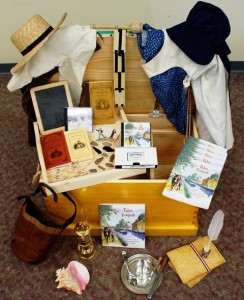National Heritage Areas: worth preserving and promoting
01 March 2013 – Eleanor Mahoney
Quick – name three National Park Service (NPS) units that commemorate, mark or otherwise emphasize the history of industrial work, or the labor movement in the United States.
Okay – Lowell National Historical Park might come to mind. Anywhere else?
Think.
Pretty hard, isn’t it? That is because there are not that many: Keweenaw National Historical Park in Michigan and Rosie the Riveter/World War II Home Front National Historical Park in California are a couple. The newly designated César E. Chávez National Monument and Paterson/Great Falls National Historical Park will also likely interpret these themes, but considering that there are roughly 400 NPS units, the scarcity of labor related sites is quite striking.

Built in 1892, the Bost Building (pictured above) served as headquarters for the Amalgamated Association of Iron and Steel Workers during the 1892 Homestead Lockout and Strike. Today, the building is a National Historic Landmark and the visitor’s center for the Rivers of Steel National Heritage Area. Credit: Rivers of Steel National Heritage Area.

In 2009, the Delaware and Lehigh National Heritage Corridor introduced the Traveling Trunks program, an innovative 4th grade curriculum for school districts along the 195-mile corridor. Each locally made trunk (pictured above) includes a variety of items, from old-fashioned games and toys to a mule feed bag and a DVD of rare canal footage. The trunk complements a full-length book, Tales of the Towpath, by Delaware and Lehigh Outreach Coordinator Dennis Scholl, which follows the life of a young boy whose father takes his family to America in 1846 and eventually becomes a canal boat captain. The program offers students an engaging and and interactive window on social and economic life in their own communities during the 19th century. Credit: Delaware and Lehigh National Heritage Corrido
Now, think about five moments in the history of work in the United States that deserve, indeed demand, some wider consideration. Here’s one list: the 1892 Homestead (PA) Strike; the 1921 Battle of Blair Mountain (WV); the 1790 opening of Slater’s Mill along the Blackstone River (RI), the first successful water powered cotton-spinning factory in the United States; the Lawrence (MA) Bread and Roses Strike of 1912; and the development of the Delaware and Lehigh Canal system in Northeast Pennsylvania, a transportation network that literally fueled the industrial revolution through the movement of anthracite coal.
What do these sites have in common? They are all located in National Heritage Areas (NHA) that now face the possibility of imminent loss of federal funding. Designated by Congress, NHAs are home to nationally significant natural, cultural and historic resources. Managed by a local organization (often, but not always, a nonprofit), heritage areas coordinate efforts to preserve, protect and where appropriate interpret the stories of a region. In addition – and this is important – they are living spaces, where people continue to work and create community. NHAs are places full of culture and tradition, where generations of residents have interacted with the natural world to create a unique and still evolving landscape.
NHAs are also significant because they can and often do play a role in interpreting the history of work in the United States – an endeavor that my colleague Richard Anderson, in an earlier blog post, called on public historians to take a more active role in fostering. Are you interested in learning more about the steel industry? Visit the Rivers of Steel National Heritage Area or the Delaware and Lehigh National Heritage Corridor. Do you want to know more about coal mining? Plan a trip to the National Coal Heritage Area or the Lackawanna Heritage Valley. How about understanding diverse methods of agriculture, farming techniques and food production? The Northern Rio Grande National Heritage Area and the Silos and Smokestacks National Heritage Area both focus on this theme along with many other important stories.
The National Heritage Areas program is currently under grave threat. Twelve areas, including the five (Rivers of Steel, National Coal, Blackstone River Valley, Essex and Delaware and Lehigh) that interpret the important labor history I outlined above, are in danger of losing their congressional authorization to receive federal funds, despite the fact they are a great financial deal for the public and cost far less to manage than a traditional NPS unit. The program as a whole also faces a severe funding reduction of some 50% in the president’s proposed budget. This is despite the fact that the current NPS Director Jon Jarvis has repeatedly and publicly praised the work of heritage areas, including in this video. Not to mention that the 2009 National Park Conservation Association’s Second Century Commission Report, Advancing the National Park Idea, praised NHAs as providing:
A collaborative model that fits well within a large-landscape-scale preservation and conservation framework. Recognizing them as long-term assets to the national park system, we recommend that Congress pass authorizing legislation creating a system of National Heritage Areas providing for permanent funding and directing full program support from the National Park Service to designated areas. (23)
The 2006 report, Charting a Future for National Heritage Areas, also gives a good idea of the importance of NHA’s to the NPS.
Right now, the future for the NHA movement is unclear and this is unacceptable. While the heritage area model is not perfect, it nonetheless represents a key aspect of 21st century preservation and conservation. Living landscapes, which tell the stories and protect the places significant to local communities, are essential to ensuring the long-term survival of both natural and historic sites -The NPS and Congress need to act now to support a vital program that connects local communities and visitors to places and events that are all too frequently ignored, distorted or forgotten.
Let’s work together to make sure that does not happen. One important step is to secure passage of the National Heritage Area Act of 2013 (H.R.445). Despite being close to 30 years old, the heritage areas program has never benefitted from an official authorizing bill (though each individual NHA has such one). Introduced by Representatives Charlie Dent (R-PA) and Paul Tonko (D-NY), co-chairs of the National Heritage Areas Caucus, the bill clarifies key program goals and sets NHAs on more secure footing with Congress. See what Preservation Action had to say about it in a recent legislative update. If you live in one of the 49 National Heritage Areas or if you just want to support this important program, contact your Senators or Representatives and urge them to sign on as co-sponsors and to support re-authorization for areas currently facing an end to their federal funding.
To learn more about National Heritage Areas visit www.nps.gov/history/heritageareas or www.nationalheritageareas.us.
~ Eleanor Mahoney is a doctoral student at the University of Washington in Seattle. From 2008-2009, she worked as the Assistant National Coordinator for Heritage Areas in that other Washington, the District of Columbia.




Ironically, history may be on the side of the funding cuts. See this new research:
http://peabodyslament.wordpress.com/2012/11/06/the-separation-of-museum-state/
T.H. Gray, Director-Curator
American Hysterical Society
I was recommended your blog by way of the step-brother. Immediately after purchasing no matter whether this text is actually prepared by way of him or her as no one else acknowledge such detailed with regards to this trouble. You will be incredible! Many thanks!